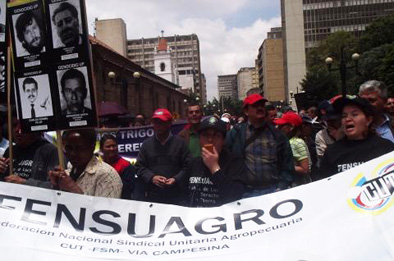By James Jordan ( Originally published in Counterpunch )

There has been an alarming escalation of repression against rural populations in Colombia. Much of this is focused against the National Unified Federation of Agricultural Workers Unions, or Fensuagro–the country’s largest labor organization representing rural workers. Fensuagro is doubly targeted not only because of the peasant farmers and workers it represents, but because it is the most prominent union in the Marcha Patriótica (Patriotic March), a social movement demanding meaningful land reform, an open and safe climate for the political opposition, unionists and human rights advocates, and popular participation in the nation’s peace process.
Repression has also been high in rural settings for unions such as the Colombian Federation of Educators, or Fecode, and for human rights defenders. It is troubling that this overlaps with the current peace process and with more than two years of the Labor Action Plan (LAP). The LAP was enacted in April 2011, calling on the Colombian government to fulfill a series of commitments in order for the US-Colombia Free Trade Agreement to be passed. Only one month later, in May, 2011, the US Trade Representative’s office announced ahead of schedule that the Colombian government had fulfilled these commitments and the FTA went into full effect.
The rising repression seems to be motivated by two primary factors: 1) the desire of the Colombian oligarchy and transnational corporate interests to augment and consolidate the appropriation of peasant land in the event of a successful peace process and land reform; and, 2) an attempt to prevent the emergence of a strong Left political bloc.
The reality for rural workers has not been one of improved labor or basic human rights. Besides the repression against labor organizers and human rights advocates, forced displacement has increased by 83% over the past year according to CODHES (the Consultancy on Human Rights and Displacement). Colombia already has the world’s highest number of internally displaced, as many as 6 million, and more than 60% of these are from farming communities. Also hard hit are indigenous and Afro-Colombian communities, with Afro-Colombians disproportionately affected the past year. Of course, farming communities can also be indigenous or Afro-Colombian, so there is much overlap.
Peasant farmers provide 70% of the food that Colombians eat. But over the past 15 years of Plan Colombia, the US and Colombia’s “war plan”, Colombians have been dispossessed of 20 million hectares of land and half the country’s land is now in the hands of 1% of the population, , according to Virginia Bouvier of the United States Institute of Peace. If one looks at the places where farmers are displaced from, without exception the areas are in or near sites wanted for the development of extractive industries, hydroelectric projects built for the export of electricity, or big agribusinesses with operations carried out by foreign corporations.
Regarding the Marcha Patriótica, many fear that this repression portends a possible repeat of the genocide against the Patriotic Union. The Patriotic Union was a Left political party founded as part of a previous peace process that was derailed when some 5,000 of its leaders, candidates and elected officials were systematically assassinated over a period of ten years.






